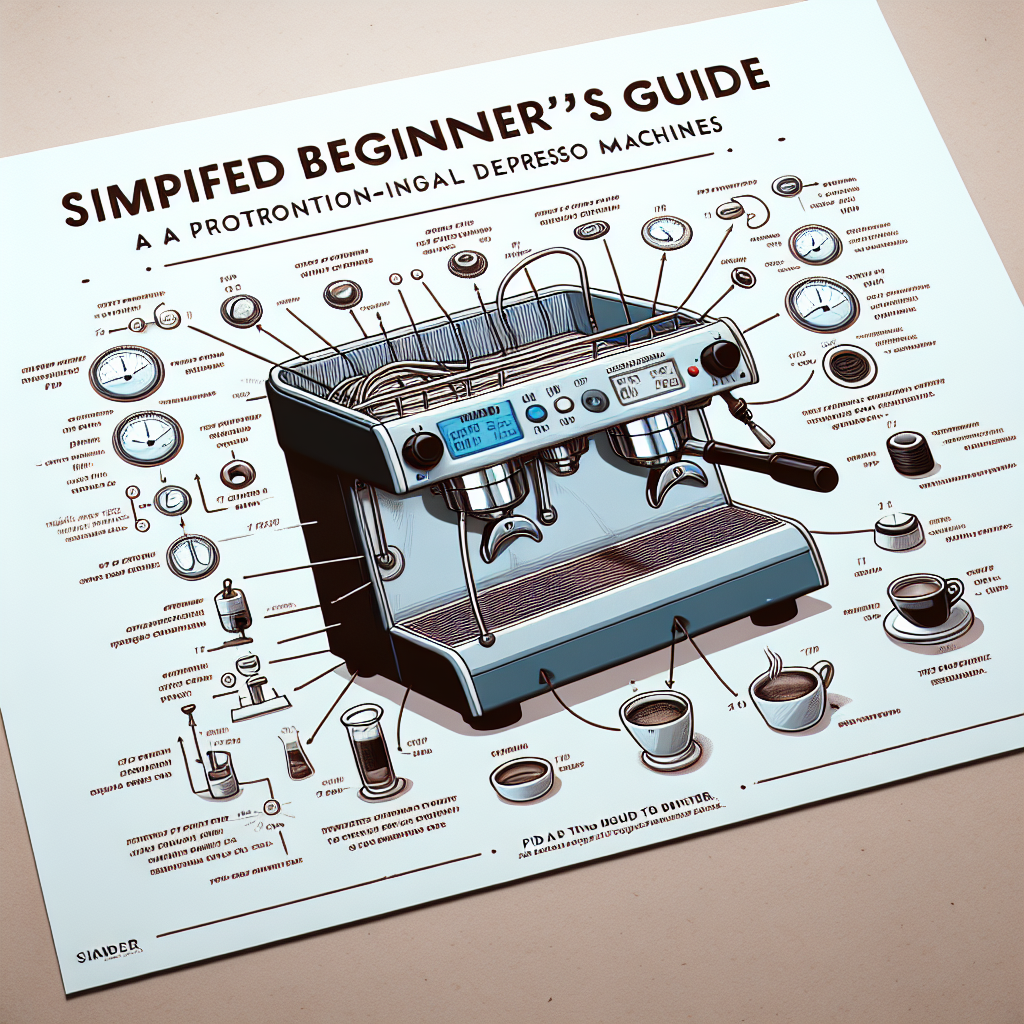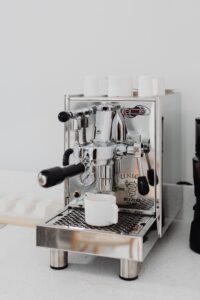
Discover the Precision of PID in Espresso Machines
Imagine sipping on an espresso that’s the epitome of perfection with every single brew. The secret? It’s all in the precision of temperature control. Enter the world of PID (Proportional-Integral-Derivative) espresso machines, where consistency is king and every cup is a masterpiece.
Article-at-a-Glance: What to Expect
- Insight into the revolutionary PID technology in espresso machines
- How PID contributes to the art of perfect espresso extraction
- Understanding the components that make up a PID system
- Guidance on selecting and using your first PID espresso machine
- Maintenance tips to keep your machine in top-notch condition
Unlocking PID Controls: How They Elevate Your Espresso
With PID controls, your espresso machine becomes a finely-tuned instrument. These smart systems manage the heat with such finesse that every variable is accounted for, ensuring your espresso is not just good, but great. It’s like having a barista’s intuition built into your machine, giving you a consistent taste that stands the test of time.
Understanding PID and Its Role in Espresso Perfection

At its core, PID is about maintaining the ideal temperature for espresso extraction. Too hot, and your coffee is burnt and bitter. Too cool, and it’s sour and under-extracted. PID keeps the temperature just right, every time, which is crucial because even a single degree can make a world of difference to your taste buds.
Defining PID: What Does It Mean for Espresso Machines?
PID stands for Proportional-Integral-Derivative, which might sound like rocket science, but it’s actually your best friend in the quest for the ultimate espresso shot. This smart controller constantly tweaks the heating elements in your machine, ensuring the water is at the perfect temperature for extracting all the rich and nuanced flavors from your coffee beans.
Exploring the Components of a PID System
The magic of a PID system lies in its three main components: the proportional, the integral, and the derivative controls. Together, they monitor and adjust the heat like a symphony conductor, making sure each note, or in this case, each degree of temperature, is pitch-perfect.
- Proportional: This part takes care of immediate temperature discrepancies, reducing the difference between the desired and actual temperatures.
- Integral: It smooths out past temperature errors, ensuring that over time, the temperature stabilizes exactly where it needs to be.
- Derivative: It predicts future temperature drifts and nips them in the bud, keeping your espresso extraction on point.
Why Temperature Matters: The Science of Espresso Extraction
Temperature is the unsung hero of espresso. It’s the difference between a flat, uninspiring cup and a dynamic, flavor-packed shot. When water passes through the coffee grounds, it should be hot enough to extract the oils and flavors but not so hot that it scorches them. PID machines are the guardians of this delicate balance, ensuring that the water temperature is spot-on for the perfect extraction.
Navigating the Features of PID Espresso Machines for Beginners

Stepping into the world of PID espresso machines can feel like a giant leap, but it’s easier than you think. These machines come packed with features that make brewing a breeze while still giving you room to grow. Let’s walk through the essentials and what they mean for your morning cup.
Selecting Your First PID Machine: Key Factors to Consider
Choosing your first PID espresso machine is a big decision, but don’t let it overwhelm you. Focus on a few key factors: ease of use, size, and price. Look for a machine that’s user-friendly, fits comfortably in your kitchen, and doesn’t break the bank. Remember, the goal is to enjoy the process, not get tangled up in technicalities.
Machine Durability and Build Quality: What You Need to Know
A good espresso machine is an investment, and like all investments, you want it to last. Pay attention to the build quality – stainless steel is your ally here. It’s not just about looks; it’s about resilience. A sturdy machine means more espressos and more smiles over the years.
The Convenience Factor: How Easy Are They to Use and Clean?
Convenience is king, especially in the morning rush. A PID machine that’s easy to use and clean will quickly become your best friend. Look for one with intuitive controls and a straightforward cleaning process. Trust me, your future self will thank you for those extra minutes saved.
The Barista’s Setup: Preparing Your PID Espresso Machine

Setting up your PID espresso machine is the first step in your barista journey. It’s about more than just plugging it in; it’s about creating a space where coffee magic happens. Ensure you have all the necessary accessories – a grinder, tamper, and fresh beans – and you’re ready to brew.
Initial Setup: A Step-by-Step Guide
Setting up your PID espresso machine is like setting the stage for a grand performance. Start by finding a stable countertop with easy access to water and power. Then, unbox your machine and position it with enough space around for your coffee-making dance. Plug it in, fill the water reservoir with fresh, filtered water, and turn it on. Let it warm up while you get to know the controls. Familiarize yourself with the buttons and dials – they’re your tools for crafting espresso excellence.
Calibrating Temperature: Tips to Get It Just Right
Calibrating the temperature on your PID espresso machine is like tuning a guitar before a concert. It’s all about hitting the right notes. Start by consulting your machine’s manual to understand the recommended temperature range. Then, using the PID controller, adjust the temperature to the lower end of that range. Pull a test shot and taste. If it’s too sour, increase the temperature slightly. If it’s too bitter, decrease it. It’s a game of small adjustments until you find your sweet spot.
First Brew: Crafting Your Perfect Shot
Now, the moment you’ve been waiting for – the first brew. Begin by grinding fresh coffee beans to a fine consistency, similar to table salt. Distribute the grounds evenly in the portafilter and tamp down firmly to create a level surface. Lock the portafilter into the group head and start the shot. Watch as the rich, caramel-colored espresso flows – this is your art in liquid form. Taste and adjust your grind, tamp, or PID settings if needed. Remember, perfection comes from practice.
Maintenance Essentials for PID Espresso Machines

Just like any high-performance tool, your PID espresso machine needs regular care to keep delivering those perfect shots. Think of maintenance as the guardian of your machine’s soul – it keeps everything running smoothly and ensures that each cup of coffee is as good as the last.
Cleaning Made Simple: Tips for Keeping Your Machine Spotless
Keeping your PID espresso machine clean is not just about hygiene; it’s about preserving the pure taste of your coffee. Start each day by wiping down the machine’s exterior with a damp cloth. After each use, clean the portafilter and basket, and purge the steam wand. Weekly, you should also backflush the group head with a cleaning solution to remove any coffee oil build-up. Make it a ritual, and your machine will reward you with longevity and flavor.
Regular Maintenance: Ensuring Your Machine’s Longevity
Aside from daily and weekly cleaning, your PID espresso machine will benefit from a deeper monthly maintenance routine. Replace water filters and check for any wear on gaskets and seals. Descale the boiler every few months, depending on the hardness of your water. And don’t forget to check the PID controller’s performance – it’s the heart of the temperature precision. With regular care, your machine will be a faithful companion on your espresso journey for years to come.
When to Descale: Preventive Care for Perfect Espresso
Descaling is like giving your espresso machine a spa day; it’s essential for its health and performance. Hard water can leave mineral deposits inside your machine, which can affect the taste of your coffee and clog the water pathways. Aim to descale every 3-6 months, but listen to your machine – if you notice a change in the water flow or the quality of your espresso, it might be time for a clean. Always use a descaling solution designed for espresso machines to avoid any damage.
Troubleshooting Tips for Common PID Machine Concerns

Even with the best care, sometimes things go awry. But don’t worry, most issues with PID machines can be resolved with a bit of troubleshooting. Let’s tackle some common concerns so you can get back to brewing that flawless espresso.
Addressing Temperature Inconsistencies
If your espresso tastes off, temperature inconsistencies could be the culprit. Start by checking the PID settings – has something been accidentally adjusted? Next, ensure your machine is properly warmed up; a cold machine can’t brew hot coffee. If the issue persists, it might be time to recalibrate the PID controller. Refer to your manual for instructions, or consider reaching out to the manufacturer for support.
Managing Error Codes: Quick Fixes and When to Seek Help
Error codes on your PID machine are like warning lights on a car dashboard – they’re telling you something needs attention. Each code corresponds to a specific issue, which you can usually find in the manual. Some fixes are simple, like refilling the water tank or cleaning a blocked filter. But if you’re faced with a persistent or unclear error code, it’s best to consult a professional. Remember, it’s better to ask for help than to risk further damage by going it alone.
Frequently Asked Questions

Can PID espresso machines also steam milk effectively?
Absolutely! PID espresso machines are not just about brewing the perfect shot; they’re also champs at steaming milk. The PID controller helps maintain a stable boiler temperature, which is crucial for producing silky, microfoam milk that’s ideal for latte art. So rest assured, with a PID machine, you’re well-equipped to create lattes, cappuccinos, and other milk-based coffee delights.
How does a PID controller differ from traditional thermostats in espresso machines?
Think of traditional thermostats like a basic on-off switch for your home’s heating – they kick in at certain temperatures and then switch off. In contrast, a PID controller is like having a smart thermostat that’s constantly making tiny adjustments to keep your home at the perfect temperature. In espresso machines, this means the PID is always fine-tuning the heat to ensure the water is at the ideal temperature for extracting all the flavors from your coffee beans without any bitterness or sourness.
Are PID espresso machines worth the investment for beginners?
For beginners, the thought of investing in a PID espresso machine might seem daunting. However, if you’re serious about your coffee, the answer is a resounding yes. PID machines take out much of the guesswork and provide a level of control that can turn a novice into a skilled home barista much quicker. Plus, they’re built to last, which means you won’t need to upgrade as soon as your skills improve. They’re the perfect tool for learning and growing in your coffee journey.
How often should I recalibrate the PID controller on my espresso machine?
Recalibrating your PID controller doesn’t need to be a frequent task. For most users, checking the calibration every few months or whenever you notice a change in the taste of your espresso should suffice. It’s also a good idea to recalibrate if you move your machine to a different environment or after descaling. Keep an eye on your shots and your taste buds will tell you when it’s time for a tune-up.
What is the typical lifespan of a PID espresso machine with proper maintenance?
With proper care and regular maintenance, a PID espresso machine can be a companion in your kitchen for many years – often up to 10 years or more. The key is to stay on top of cleaning, descaling, and replacing any worn parts as needed. Remember, a well-maintained machine not only lasts longer but also ensures each cup of coffee is as delicious as the first.
So go ahead, embrace the art and science of PID espresso machines, and let the journey to the perfect espresso shot begin!


